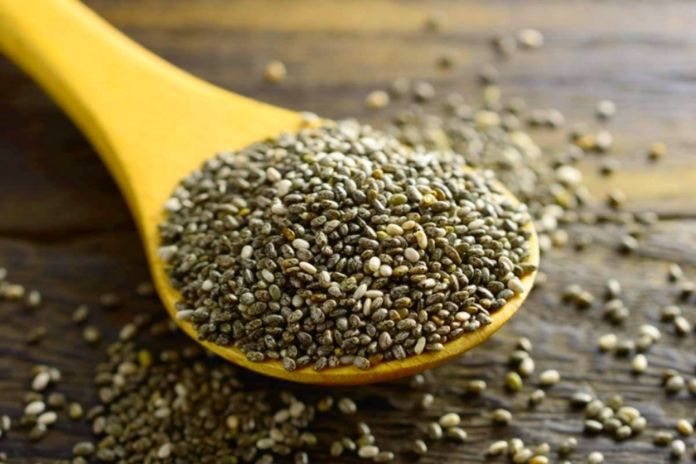These tiny dark seeds of the chia plant (Salvia Hispanica) are rich in calcium, vitamin C, and omega-3s. They are therefore helpful for the health of the intestine, the nervous system, and the heart. The chia seeds are from Mexico and Guatemala and were a staple food for the ancient Aztecs and Mayans.
What Are Chia Seeds?
Chia seeds are, in fact, the edible seeds of a plant of the genus Salvia, belonging to the Labiatae family. They have an oval shape and a grayish color, with black and white markings.
Nutritional Values
100 g of chia seeds contain
- 534 kcal;
- proteins 18.3 g;
- fats 42.1 g;
- saturated fat 3.6 g;
- carbohydrates 28.8 g;
- sugars 1.5 g;
- fibers 27.3 g.
Chia Seeds Have Numerous Nutritional Properties
They are considered the primary plant source of omega-3 fatty acids. These are defined as essential fatty acids, that is, molecules that our body cannot synthesize independently, and it is necessary to introduce them with the diet. In particular, 75% of the fats present in chia seeds are represented by omega-3 alpha-linolenic fatty acid (ALA), while the remaining 20% are by omega-6 fatty acids.
Almost all carbohydrates present are represented by fibers, that is, carbohydrates that our body cannot digest but are essential for staying healthy. The guidelines recommend getting at least 25g of fiber per day. With an average portion of 30 g of chia seeds, we meet 32% of our needs. In addition, chia seeds are rich in proteins (18%) defined as high quality, as they provide all nine essential amino acids.
In addition to macronutrients (fats, proteins, and carbohydrates), chia seeds are rich in micronutrients, particularly minerals. These include manganese, calcium, phosphorus, copper, iron, selenium, and magnesium. Finally, we find numerous antioxidants, including chlorogenic and caffeic acid, quercetin, and kaempferol.
Properties And Benefits
Chia seeds are a concentrate of precious nutrients, which give them numerous properties:
- They counteract inflammation, improve the activity of the central nervous system and cardiovascular health, thanks to the high content of omega-3 fatty acids;
- They promote intestinal health, regulate blood sugar levels and improve insulin resistance (lowering the risk of diabetes 2), thanks to the high fiber content;
- They favor the sense of satiety, thanks to the protein intake;
- Promote the health of bones, heart, muscles, and nerves, thanks to the high mineral content;
- They improve blood pressure, thanks to the presence of chlorogenic acid;
- They reduce cardiovascular risk, the risk of osteoporosis and cancer, thanks to quercetin and kaempferol.
Contraindications
There are no particular contraindications in the intake of chia seeds if adequately introduced in the diet. Excessive consumption, however, could cause gastrointestinal upset due to their high fiber content. Furthermore, due to their positive action on blood sugar and blood pressure, it is good to moderate their consumption if you take drugs to improve these values.
How Many Chia Seeds To Eat Per Day?
A serving of nuts or oilseeds is about 30g per day.
How Are Chia Seeds Used For Weight Loss?
Chia seeds absorb a lot of water, so using chia seeds promotes satiety and helps keep hunger at bay by avoiding nibbling during the day. However, it should be noted that no food can promote weight loss, for which the best strategy remains that of the caloric deficit determined by personalized nutrition and movement.
How To Eat Chia Seeds?
Chia seeds are very versatile and can be used in a variety of ways. They can be added to yogurt, porridge, breakfast cereals, and salads for crunchiness. Soaked, they absorb water and create a gel that can be used to replace eggs in doughs. The gel can also be helpful in cases of intestinal irregularity and is formed by soaking a tablespoon of chia seeds in half a glass of water for at least thirty minutes.
Other Uses
The use of chia seeds is extensive as these foods are almost tasteless and can be added to any dish or food without altering its taste. For example, leavened products can be added to the dough, such as focaccia, pizza, or wholemeal bread, in cereal and legume soups or biscuit dough, to give more crunchiness. You can also make chia seed butter at home by adding 100g of chia seed gel to vegetable butter in the same amount. The mixture, when pureed, can be stored in the refrigerator like regular butter.
Recipes
Among the most practical and everyday recipes with chia seeds is chia seed pudding, also known as chia pudding. To prepare it, it will be sufficient to soak 30 g of chia seeds in about 200 ml of cow’s milk or vegetable drink overnight in the refrigerator, in a bowl. In the morning, the chia seeds will have absorbed the liquids, and the mixture will have a consistency similar to that of a pudding, which can be garnished with yogurt, fresh fruit, and unsweetened cocoa.
ALSO READ: PROPERTIES AND BENEFITS OF PAPAYA, THE FRUIT OF VITALITY

